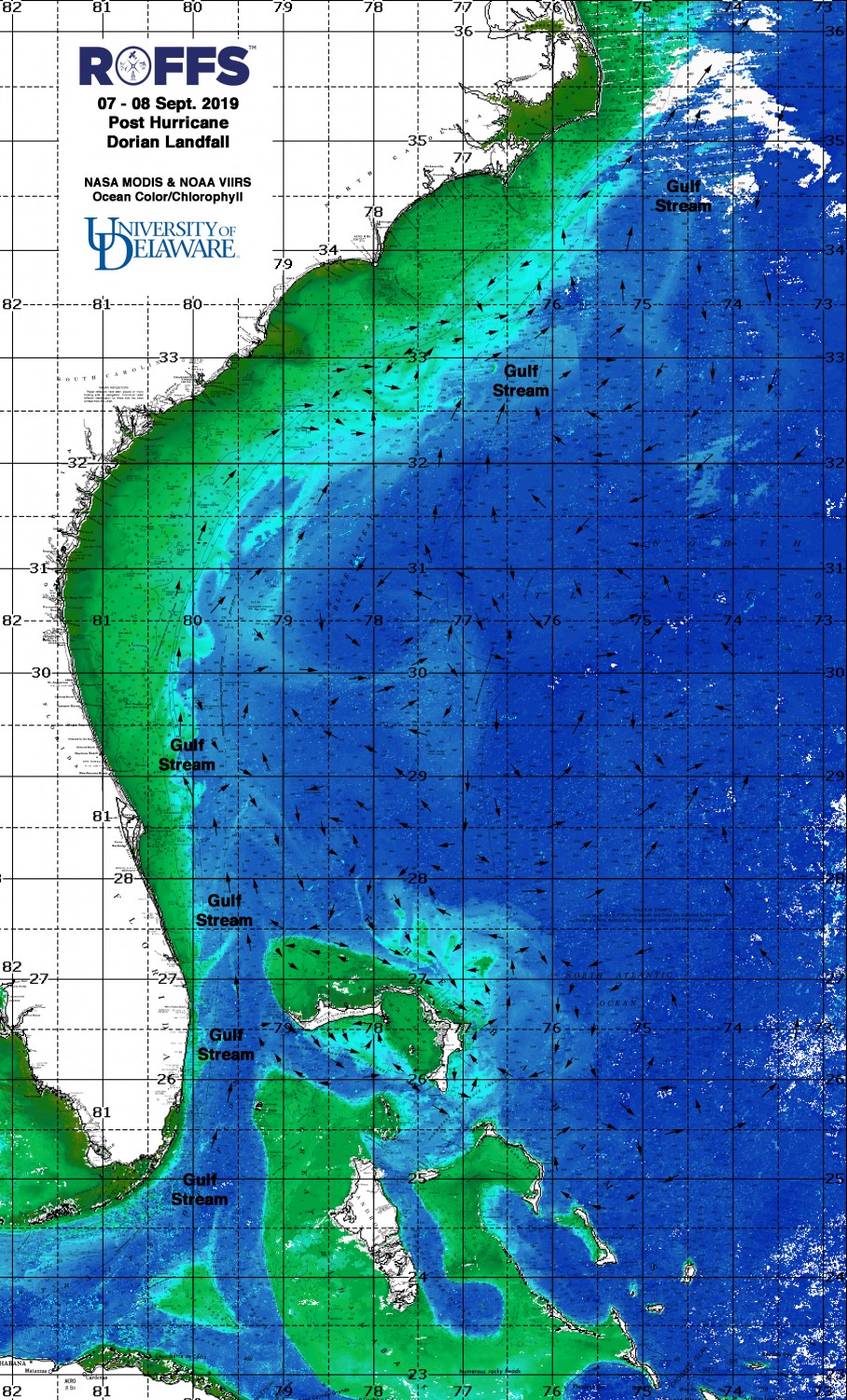Our thoughts and prayers are with the residents of the Bahamas and Outer Banks after the impacts they’ve experienced due to Hurricane Dorian. ROFFS™, in affiliation with the Southeast Coastal Ocean Observing Regional Association (SECOORA) https://secoora.org/ have monitored Hurricane Dorian and the oceanographic conditions caused by this storm and we have summarized the results below.
PRE-Dorian SST (August 27-29, 2019) – image 1 top left hand side
This image shows the Sea Surface Temperature (SST) composite from two to three days before Hurricane Dorian impacted the Bahamas and moved west/northwestward along the coast of the southern United States. Of note is the warmer, Gulf Stream temperatures near 84°F-85°F from Florida northward towards the Carolinas. Additionally, the difference in SST° of the core of the Gulf Stream is only 1.0°F-2.0°F different from the surrounding water, making it relatively difficult to determine the edges of the Gulf Stream water. As for the Bahamas, we can observe the expected eddy formations within the Northwest Providence Channel, south of Grand Bahama Island, as well as a clockwise eddy east of Abaco.
PRE-Dorian Ocean Color/Chlorophyll (August 27-31, 2019) – image 2 top right hand side
Using NASA’s MODIS and NOAA’s VIIRS ocean color/chlorophyll imagery, we have shown the relative levels of turbid water over inshore waters of the Bahamas and along the southeastern United States. These features line up fairly well with the water mass boundaries observed in the corresponding pre-hurricane SST° imagery.
POST-Dorian SST (September 7-8, 2019) – image 3 bottom left hand side
This image shows a two to three day SST composite image from after Hurricane Dorian moved northeast of Cape Hatteras, NC. As you can see, the overall SST has dropped by 3°F-4°F throughout much of the area as a result of wind mixing. Additionally, several larger eddy formations have developed offshore of Georgia, South Carolina, and North Carolina making it difficult to determine the location of the core of the Gulf Stream. We have indicated where we believe the core may be located. Additionally, several counter-clockwise eddy formations have developed north and east of Abaco. South of Grand Bahama Island, the counter-clockwise rotating eddy formation has been reduced and pushed further northward towards the shore.
POST-Dorian Ocean Color/Chlorophyll (September 7-9, 2019) – image 4 bottom right hand side
One can see a significant difference in the ocean color/chlorophyll imagery after Hurricane Dorian made landfall in the Bahamas remaining stationary for quite some time and as it tracked west/northwestward and pulled turbid water offshore along the eastern U.S. coastline. Greener, more turbid, water has been pulled offshore in the northeastern corner of the Northwest Providence Channel between Grand Bahama Island and Abaco. Additionally, you can see green to blue green water that has been pulled east-northeast off of Abaco out over the Blake Plateau. Westward, greener freshwater runoff has been observed well offshore from Florida and northward especially offshore of the coasts of South Carolina and North Carolina. We can observe green to blue green water being pulled offshore towards and into the Gulf Stream south of the Cape Fear, NC area.
Please contact ROFFS™ (321.723.5759/fish7@roffs.com) for further information on the effects of Hurricane Dorian or for tracking the polluted freshwater outflow plumes resulting from the storm.
Before Hurricane Dorian
[/et_pb_text][/et_pb_column][/et_pb_row][et_pb_row][et_pb_column type=”1_2″][et_pb_image _builder_version=”3.22.7″ src=”https://roffs.com/wp-content/uploads/2019/09/Hurricane-Dorian-PRE-SST.jpg” show_in_lightbox=”on” z_index_tablet=”500″ /][/et_pb_column][et_pb_column type=”1_2″][et_pb_image _builder_version=”3.22.7″ src=”https://roffs.com/wp-content/uploads/2019/09/Hurricane-Dorian-PRE-CHL.jpg” show_in_lightbox=”on” z_index_tablet=”500″ /][/et_pb_column][/et_pb_row][et_pb_row][et_pb_column type=”4_4″][et_pb_text _builder_version=”3.22.7″ text_text_shadow_horizontal_length=”text_text_shadow_style,%91object Object%93″ text_text_shadow_vertical_length=”text_text_shadow_style,%91object Object%93″ text_text_shadow_blur_strength=”text_text_shadow_style,%91object Object%93″ link_text_shadow_horizontal_length=”link_text_shadow_style,%91object Object%93″ link_text_shadow_vertical_length=”link_text_shadow_style,%91object Object%93″ link_text_shadow_blur_strength=”link_text_shadow_style,%91object Object%93″ ul_text_shadow_horizontal_length=”ul_text_shadow_style,%91object Object%93″ ul_text_shadow_vertical_length=”ul_text_shadow_style,%91object Object%93″ ul_text_shadow_blur_strength=”ul_text_shadow_style,%91object Object%93″ ol_text_shadow_horizontal_length=”ol_text_shadow_style,%91object Object%93″ ol_text_shadow_vertical_length=”ol_text_shadow_style,%91object Object%93″ ol_text_shadow_blur_strength=”ol_text_shadow_style,%91object Object%93″ quote_text_shadow_horizontal_length=”quote_text_shadow_style,%91object Object%93″ quote_text_shadow_vertical_length=”quote_text_shadow_style,%91object Object%93″ quote_text_shadow_blur_strength=”quote_text_shadow_style,%91object Object%93″ header_text_shadow_horizontal_length=”header_text_shadow_style,%91object Object%93″ header_text_shadow_vertical_length=”header_text_shadow_style,%91object Object%93″ header_text_shadow_blur_strength=”header_text_shadow_style,%91object Object%93″ header_2_text_shadow_horizontal_length=”header_2_text_shadow_style,%91object Object%93″ header_2_text_shadow_vertical_length=”header_2_text_shadow_style,%91object Object%93″ header_2_text_shadow_blur_strength=”header_2_text_shadow_style,%91object Object%93″ header_3_text_shadow_horizontal_length=”header_3_text_shadow_style,%91object Object%93″ header_3_text_shadow_vertical_length=”header_3_text_shadow_style,%91object Object%93″ header_3_text_shadow_blur_strength=”header_3_text_shadow_style,%91object Object%93″ header_4_text_shadow_horizontal_length=”header_4_text_shadow_style,%91object Object%93″ header_4_text_shadow_vertical_length=”header_4_text_shadow_style,%91object Object%93″ header_4_text_shadow_blur_strength=”header_4_text_shadow_style,%91object Object%93″ header_5_text_shadow_horizontal_length=”header_5_text_shadow_style,%91object Object%93″ header_5_text_shadow_vertical_length=”header_5_text_shadow_style,%91object Object%93″ header_5_text_shadow_blur_strength=”header_5_text_shadow_style,%91object Object%93″ header_6_text_shadow_horizontal_length=”header_6_text_shadow_style,%91object Object%93″ header_6_text_shadow_vertical_length=”header_6_text_shadow_style,%91object Object%93″ header_6_text_shadow_blur_strength=”header_6_text_shadow_style,%91object Object%93″ z_index_tablet=”500″]After Hurricane Dorian
[/et_pb_text][/et_pb_column][/et_pb_row][et_pb_row][et_pb_column type=”1_2″][et_pb_image _builder_version=”3.22.7″ src=”https://roffs.com/wp-content/uploads/2019/09/Hurricane-Dorian-Post-SST.jpg” show_in_lightbox=”on” z_index_tablet=”500″ /][/et_pb_column][et_pb_column type=”1_2″][et_pb_image _builder_version=”3.22.7″ src=”https://roffs.com/wp-content/uploads/2019/09/Hurricane-Dorian-POST-CHL.jpg” show_in_lightbox=”on” z_index_tablet=”500″ /][/et_pb_column][/et_pb_row][/et_pb_section]





